Islam and Architecture
Islam and Architecture | Cultural Foundations and Global Influence in Design
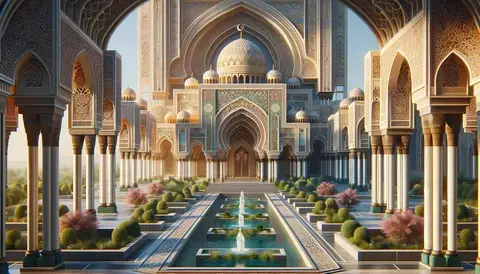
➤ Did you know that the earliest mosque, built by the Prophet Muhammad in Medina, was not just a place of worship but a community center, a courtroom, and a school? This multifunctional approach has influenced Islamic architectural designs for centuries, creating spaces that are both aesthetically stunning and deeply functional.
Islamic Design: Exploring the Influence of Islam on Architecture
This new 2024 research explores the profound relationship between Islamic teachings and architectural practices. From the bustling markets of Istanbul to the serene gardens of the Alhambra, Islamic architecture offers a unique blend of practicality, beauty, and spirituality. Here, we explore the evolution, core elements, and global impact of this architectural style, providing insights into how it has shaped and been shaped by the cultures it has touched.
Introduction
- Overview: Introduce the symbiotic relationship between Islamic principles and architectural innovation.
- Purpose: Outline the article's goal to dissect how Islamic cultural and religious influences have shaped architectural styles across various epochs and regions.
Overview:
Islamic architecture is more than just a means of constructing buildings; it's a profound expression of spiritual devotion and practicality fused into one. The intricate designs of Islamic buildings are not merely for aesthetic pleasure; they reflect a deep symbiotic relationship between religious principles and architectural innovation. This connection manifests in every archway, courtyard, and minaret, showcasing a unique blend of form and function that has captivated the world for centuries.
Purpose:
This article aims to dissect and examine how Islamic cultural and religious influences have shaped architectural styles throughout history. By exploring mosques, palaces, and various civil structures across different epochs and regions, we'll see how Islamic architecture has been both a product of and a contributor to the cultural landscapes it touches. From the sands of the Arabian Peninsula to the streets of Andalusia, Islamic architectural principles have left an indelible mark, adapting to local traditions while retaining a core set of stylistic and spiritual elements.
Islamic architecture not only reflects spiritual and practical aspects of Muslim life but has also significantly influenced global architectural trends.
At its heart, Islamic architecture exemplifies how built environments can reflect the spiritual and practical aspects of life. It offers a sanctuary for worship while serving the communal and educational needs of society. Furthermore, the influence of Islamic architecture extends well beyond the Muslim world, affecting global architectural trends and inspiring countless artists, architects, and scholars. Through this exploration, we aim to highlight the rich contributions of Islamic design principles to the global architectural heritage, demonstrating their enduring relevance in contemporary design discussions.
By understanding these dynamics, readers will gain insights into the profound impact of religion and culture on architectural practices, and how these practices have woven Islamic identity into the very fabric of cities and civilizations around the world.
Historical Overview
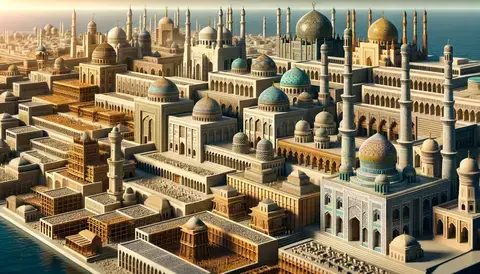
- Origins of Islamic Architecture: Trace the development from simple structures to elaborate mosques and palaces.
- Key Dynasties and Their Contributions: How the Umayyads, Abbasids, Ottomans, and Mughals each added layers to the architectural legacy.
- Expansion Across Continents: The spread of Islamic architectural principles to Europe, Asia, and Africa through trade and conquest.
Origins of Islamic Architecture: Islamic architecture originated in the 7th century with the construction of the Prophet Muhammad's mosque in Medina, a simple structure made of palm trunks and mud walls. This humble beginning set the foundation for an architectural revolution that would eventually produce some of the world's most spectacular buildings. As Islam spread across the Arabian Peninsula, the architectural styles evolved to include more complex structures such as the Umayyad Mosque in Damascus, which introduced large courtyards and expansive prayer halls.
Key Dynasties and Their Contributions: Each major Islamic dynasty brought its own innovations and styles to the architecture that followed. The Umayyads (661-750 AD) are known for their monumental structures and introduction of the dome and minaret into mosque design. The Abbasids, who followed, emphasized grandeur with their capital in Baghdad, featuring intricate brickwork and large city plans. The Ottomans (1299-1923 AD) mastered the art of dome construction, epitomized by the Hagia Sophia's conversion into a mosque, which influenced mosque design for centuries. The Mughals in South Asia (1526-1857 AD) introduced a blend of Islamic and local Indian styles, leading to the creation of iconic structures like the Taj Mahal with its large marble domes and detailed inlay work.
Expansion Across Continents: Islamic architectural principles expanded far beyond their origins in the Middle East due to trade, conquest, and the spread of Islamic culture. In North Africa, the spread of Islam brought Moroccan and Andalusian styles, which featured intricate tile work and ornate gardens. In Europe, particularly in Spain and the Balkans, Islamic architecture introduced sophisticated water systems and lush gardens, seen in the Alhambra Palace. In Asia, from the steppes of Central Asia to the islands of Indonesia, Islamic architecture adapted local materials and techniques, which can be seen in the varied mosque designs from the minarets of Samarkand to the wooden mosques of Southeast Asia.
This widespread influence not only highlights the adaptability and appeal of Islamic architectural principles but also shows how they have been integrated into various cultural and environmental contexts around the world.
Key Architectural Elements in Islamic Buildings
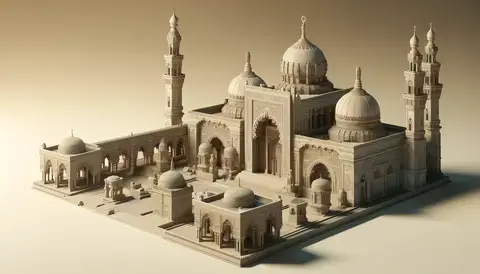
- Distinctive Features: Detailed analysis of arches, domes, minarets, and courtyards typical in Islamic architecture.
- Ornamentation and Symbolism: Exploration of arabesque, calligraphy, and geometric patterns that embody Islamic spiritual concepts.
- Innovations: Examination of structural innovations such as squinches, muqarnas, and the development of the pointed arch.
Key Architectural Elements in Islamic Buildings
Distinctive Features: Islamic architecture is renowned for several distinctive features that are integral to its identity. Arches, which vary from simple rounded forms to intricate, multifoloid designs, serve not only structural purposes but also add aesthetic value. Domes are another critical element, often used to crown mosques and create a dramatic interior space that represents the vault of heaven in Islamic cosmology. Minarets, the tall, slender towers associated with mosques, are used for the call to prayer and as a visual focal point that can be seen from a great distance. Courtyards are common in Islamic architecture; they provide a communal space that is both versatile for gatherings and practical for climate control, allowing air to circulate and light to fill the space.
Ornamentation and Symbolism: Ornamentation in Islamic architecture is not merely decorative but laden with deep symbolic meaning, often reflecting spiritual concepts of the infinite and the divine. Arabesque patterns, which feature repeating geometric forms and intertwined foliage, symbolize the transcendent, infinite nature of creation. Calligraphy is also a prominent element, used to adorn buildings with verses from the Quran, thereby integrating divine guidance into the fabric of everyday life. Geometric patterns are particularly significant, as they represent the unchanging laws of God manifest in the natural world, through unending repetition that suggests infinity.
Innovations: Islamic architects were pioneers in structural innovation, creating solutions that allowed for more elaborate constructions. Squinches, for example, are architectural features that transition the space between square room bases and circular domes, an innovation that allowed for the widespread use of domes in Islamic buildings. Muqarnas are ornamental vaulting forms that appear to cascade downwards, creating a stunning visual effect that also distributes the weight of the dome above. The development of the pointed arch, another significant innovation, not only strengthened structures but also enhanced the aesthetic and spatial dynamics of Islamic buildings, influencing Gothic architecture in Europe as well.
These elements and innovations not only contribute to the functionality and beauty of Islamic structures but also embody the cultural and religious ethos of the civilizations that built them, making Islamic architecture one of the most distinct and influential architectural styles in the world.
Role of Religion in Islamic Architecture

- Functional and Symbolic Aspects: Analysis of how mosques serve as centers of worship and community, and how architectural elements symbolize Islamic beliefs.
- Architectural Orientation and Elements: Discuss the importance of Qibla and Mihrab in mosque design, emphasizing directional and spiritual significance.
The Role of Religion in Islamic Architecture
Functional and Symbolic Aspects: In Islamic architecture, the mosque serves as the focal point of religious and communal life. These structures are designed not only as places of worship but also as centers for education, social interaction, and civic administration, embodying the holistic approach of Islam towards community and spirituality. Architecturally, every element of a mosque has both a functional and a symbolic aspect. For instance, the large, central prayer hall supports congregational prayers, which are a fundamental aspect of Islamic worship, emphasizing community and equality among worshippers.
Symbolically, many elements within Islamic architecture reflect deep-seated beliefs and values. The expansive courtyards symbolize the openness and inclusivity of Islam, inviting all to enter and participate in communal activities. The use of water in Islamic gardens and courtyards represents purity, life, and the flow of divine grace. The intricate geometric designs that adorn Islamic buildings are a manifestation of the universe's complex and infinite nature, which can only be fully understood through divine wisdom.
Architectural Orientation and Elements: The orientation of a mosque towards the Kaaba in Mecca is a defining characteristic of Islamic architecture. This direction, known as the Qibla, is crucial because it provides a unified direction of prayer for all Muslims, symbolizing unity and cohesion within the Islamic community worldwide. Every mosque, no matter where it is in the world, features a Mihrab—a niche in the wall that indicates the Qibla. This not only serves a practical purpose by showing the direction of prayer but also has spiritual significance, marking the presence of an axis mundi, a link between the earthly and heavenly realms.
Additionally, the architectural design often incorporates a Minbar, or pulpit, from where Friday sermons are delivered, symbolizing guidance and leadership. The positioning and design of these elements are carefully considered to enhance spiritual contemplation and communal worship.
The role of religion in Islamic architecture is profound, influencing the design and orientation of buildings in a way that integrates functional needs with spiritual symbolism. This integration ensures that the architecture itself becomes a part of the religious experience, fostering a built environment that is deeply rooted in Islamic cultural and religious identity.
Global Influence of Islamic Architecture
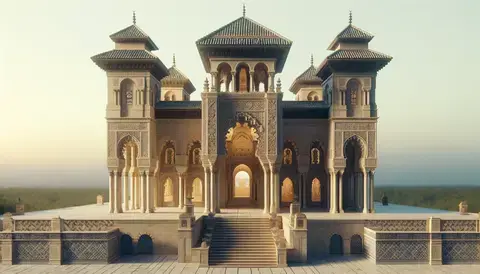
- Impact on World Architecture: Explore how Islamic architectural principles have influenced global building styles, including adaptations in non-Muslim countries.
- Influence on European Architecture: Detail the significant impact of Islamic architecture on European styles, particularly during the medieval period, influencing Gothic architecture and the Renaissance through examples like the Palazzo Vecchio in Florence and the use of arabesque motifs.
Global Influence of Islamic Architecture
Impact on World Architecture: Islamic architecture has made substantial contributions to global building styles, influencing architectural development far beyond its geographic and cultural origins. Its impact is particularly notable in the use of ornamental design, structural innovations, and the integration of indoor and outdoor spaces. For instance, the adoption of Islamic architectural elements like pointed arches, ribbed vaults, and intricate tile work played a pivotal role in the evolution of Gothic Architecture in Europe. Moreover, the spread of Islamic geometric patterns and garden designs can be seen in the Renaissance gardens of Europe and the Mudejar art of Spain, which blend Islamic and Western styles.
Influence on European Architecture: The influence of Islamic architecture on European styles was facilitated through various channels, including the Crusades, trade, and the Reconquista of Spain. This influence is most evident in the architecture of regions like Sicily and Andalusia, where Islamic and Western architectural elements merge seamlessly. The Alhambra in Spain, for instance, stands as a testament to Islamic architectural and artistic influence, with its elaborate arabesques and intricate stucco work, which have inspired countless Western architectural works. Additionally, Venetian Gothic architecture, with its pointed arches and ornate detailing, owes much to the Islamic architectural heritage of the Mediterranean.
This profound influence showcases the adaptability and enduring appeal of Islamic architectural principles, and how they have been embraced and integrated into various cultural contexts around the world, enriching global architectural heritage.
What's next? Let's get into some of the most notable examples of Islamic architecture that highlight the unique and influential design elements characteristic of this style.
Notable Examples of Islamic Architecture
- Iconic Mosques: From Al-Haram Mosque in Mecca to the Blue Mosque in Istanbul.
- Palatial and Civil Structures: Coverage of the Alhambra in Spain and the Taj Mahal in India.
- Contemporary Examples: Modern buildings that integrate Islamic architectural principles, such as the Louvre Abu Dhabi.
Examples of Islamic Architecture
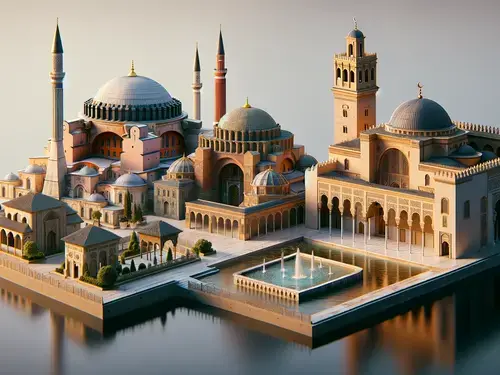
Landmark Structures: Islamic architecture is rich with examples that not only demonstrate architectural ingenuity but also cultural significance. Among these, the Hagia Sophia in Istanbul stands out. Originally a Byzantine church, it was converted into a mosque after the Ottoman conquest and now serves as a museum. Its massive dome, supported by pendentives, has inspired architects for centuries and represents a fusion of Christian and Islamic architectural elements.
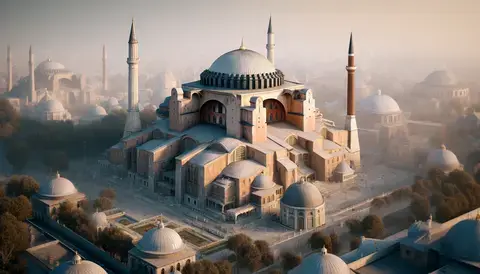
Another exemplary structure is the Alhambra in Granada, Spain. Known for its sophisticated decorative arts and advanced hydraulic systems, the Alhambra exemplifies the Moorish style in the Western world, blending Islamic art with Gothic and Renaissance elements. Its use of light, water, and geometry creates a paradise on earth, a common theme in Islamic aesthetics.
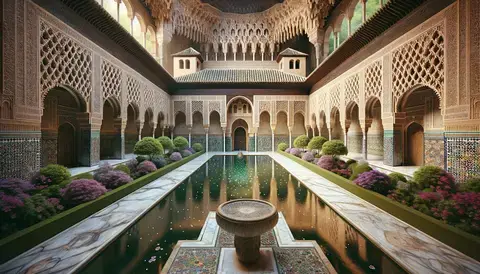
The Great Mosque of Córdoba is another architectural marvel, featuring a hypostyle hall with 856 columns made from jasper, onyx, marble, and granite. The mosque's famous double-arches inspired by Roman aqueducts allow for higher ceilings and have become a symbol of Islamic architectural innovation.
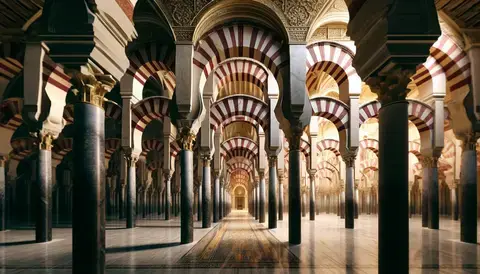
Modern Marvels: In modern times, Islamic architecture continues to evolve while maintaining its distinct identity. The Museum of Islamic Art in Doha, designed by I.M. Pei, is a contemporary interpretation of Islamic architecture. The museum blends traditional Islamic architectural elements such as geometric patterns and water features with modern design and technology, creating a bridge between the past and the present.

The Sheikh Zayed Grand Mosque in Abu Dhabi is another modern architectural feat, accommodating over 40,000 worshippers. It features 82 domes of Moroccan design and an immense Persian carpet, one of the largest in the world. Its design incorporates materials and craftsmanship from around the world, symbolizing the universal message of Islam.
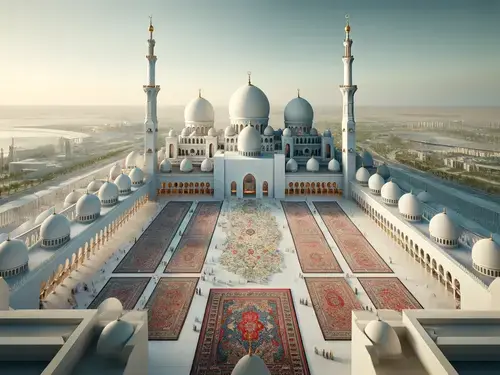
These structures not only highlight the architectural advancements but also the cultural, philosophical, and spiritual ideologies that Islamic architecture promotes. Each building, whether ancient or modern, carries with it the narratives of the civilizations that built them, making Islamic architecture a pivotal chapter in the global architectural discourse.
Next, we'll explore how regional variations have influenced the distinct styles of Islamic architecture across different geographies.
Regional Variations
- Diversity Within Regions: Contrast the architectural styles and influences in the Middle East, South Asia, North Africa, and the remnants of Moorish architecture in Southern Europe.

Variations in Islamic Architecture
Distinct Styles Across Regions: Islamic architecture displays a fascinating array of styles that reflect the local cultures and environments where Islam took root. This diversity is evident from the Middle East to North Africa, and from Southern Europe to Southeast Asia, each adapting Islamic architectural principles to local traditions and climatic conditions.
In the Middle East, the architecture often features massive domes and spacious courtyards which are suited to both the social customs and the hot, arid climate of the region. The use of intricate tile work and expansive water features in places like Iran showcases the Persian influence, which emphasizes beauty, symmetry, and the use of gardens as a representation of paradise.
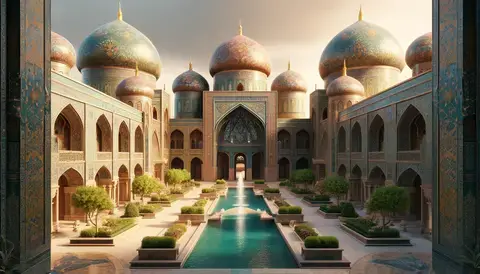
North Africa sees a different adaptation, where the architecture often incorporates thick walls and narrow windows to combat the heat. The iconic riads of Morocco, with their internal courtyards and water features, reflect a unique blend of Arab, Berber, and even Andalusian influences, highlighting the importance of privacy and family life in the architectural design.
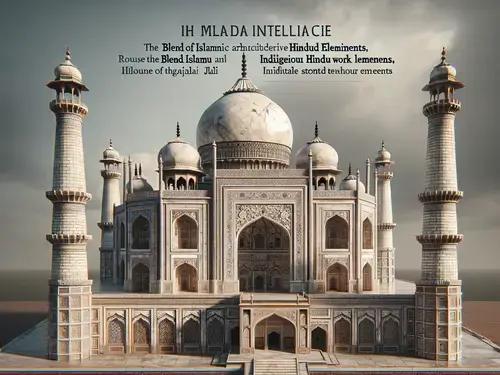
South Asia’s Islamic architecture features a blend of Islamic and indigenous Hindu elements, as seen in the Mughal architecture of India. Structures like the Taj Mahal not only display the Persian influences typical of Islamic architecture but also include local materials and techniques, such as the jali – intricately carved stone screens that filter light and air.
In Southeast Asia, Islamic architecture often incorporates local materials such as wood and adopts tiered roofs rather than domes, which are more suited to the tropical climate. The mosques in Indonesia, for example, display a significantly different aesthetic from those in the Arab world, yet they maintain the same function and spiritual symbolism.
European Adaptations are most prominently seen in Spain, particularly in the region of Andalusia. The Moorish architecture here, exemplified by the Alhambra, integrates Islamic art with Gothic and Renaissance elements, creating a fusion that has left a lasting architectural legacy in the region.
Contemporary Issues and Future Directions: As we explore the contemporary issues facing Islamic architecture today, such as preservation challenges and the incorporation of modern technology, we will see how these historical and regional styles continue to influence modern design while adapting to the needs of the 21st century.
Next, we'll look into the contemporary challenges and future directions in Islamic architecture, focusing on preservation efforts, sustainability, and the integration of new technologies in historical contexts.
Contemporary Issues and Future Directions
- Preservation Efforts: Discuss the challenges and strategies in preserving historic Islamic architecture.
- Modern Adaptations and Sustainability: How contemporary architects are blending Islamic traditions with modern sustainability practices and technologies.
Contemporary Issues and Future Directions in Islamic Architecture
Preservation Challenges: One of the major contemporary issues facing Islamic architecture is the preservation of historical sites. Many ancient structures are at risk due to urban expansion, environmental degradation, and conflict. Efforts to preserve these architectural treasures often involve complex restoration techniques that must balance historical accuracy with modern safety and accessibility standards. For instance, the restoration of the Al-Nuri Mosque in Mosul, heavily damaged during conflicts, involves not only rebuilding the physical structure but also preserving its historical and cultural significance for future generations.
Sustainability and Modern Technology: As global awareness of environmental issues increases, the field of Islamic architecture is also embracing sustainable practices. This involves both the retrofitting of existing buildings with green technologies and the design of new structures that incorporate traditional methods of environmental control with modern advancements. For example, many new mosque designs include features for natural cooling, use of solar energy, and water recycling, reflecting the Islamic commitment to stewardship of the Earth.
Additionally, the use of technology in the form of 3D modeling and digital simulations has become crucial in both preserving and constructing Islamic architecture. These tools allow architects to explore complex geometric patterns and structural solutions before actual construction begins, ensuring that new developments are both aesthetically in line with traditional styles and robust enough for modern needs.
Future Directions: Looking forward, Islamic architecture is likely to continue its rich tradition of blending beauty, functionality, and spirituality while adapting to contemporary needs and technologies. This includes greater integration of smart technologies and further exploration of sustainable building practices that reflect Islamic environmental ethics. Moreover, as the global interest in Islamic culture and heritage grows, we can expect to see more educational and cultural projects aimed at promoting understanding and preservation of this influential architectural style.
Conclusion: Key Takeaways on Islam and Architectural Influence
Recap of Insights: Islamic architecture, with its intricate designs and profound symbolic expressions, has not only stood the test of time but has continued to evolve and influence. The legacy of Islamic architecture is evident in the silhouettes of skylines around the world, from the minarets of Middle Eastern mosques to the Moorish influences in the palaces of Spain. This architectural style has mastered the balance between functionality and aesthetics, serving both the spiritual needs of the Muslim community and the communal needs of society at large.
Cultural Impact: The cultural, religious, and aesthetic contributions of Islamic architecture are profound and far-reaching. It has shaped not just buildings but also the urban landscapes and social structures of cities across the Middle East, Africa, Asia, and Europe. The emphasis on intricate detail and geometric harmony in Islamic architecture reflects a deeper spiritual pursuit, showcasing the religion's commitment to beauty and precision. These principles have transcended Islamic culture, influencing Western art and architecture and contributing to a more interconnected global architectural heritage.
Future Prospects: As we look to the future, Islamic architectural principles are increasingly being integrated into modern and sustainable architecture. This integration is seen in the use of traditional techniques for natural cooling, the incorporation of green spaces in urban design, and the thoughtful use of materials to minimize environmental impact. Furthermore, the global architectural community continues to explore and celebrate Islamic architecture through academic studies, exhibitions, and collaborations that ensure its techniques and philosophies contribute to contemporary design practices.
In summary, Islamic architecture is a dynamic field that continues to inspire, innovate, and influence across centuries and cultures. Its ability to adapt to modern demands while maintaining its unique identity suggests that its influence will persist and evolve in the architectural landscapes of the future. This enduring relevance not only honors its rich history but also paves the way for its vibrant future in the global architectural narrative.
Further Reading and Resources
Recommended Literature: For those seeking a deeper understanding of Islamic architecture, the following books and articles are invaluable resources:
- "The Art and Architecture of Islam, 1250–1800" by Sheila S. Blair and Jonathan M. Bloom - This book provides a comprehensive survey of Islamic art and architecture from the Mongol conquests in the mid-13th century to the beginnings of modernism.
- "Architecture of the Islamic World: Its History and Social Meaning" by George Michell - Offering insights into the social and historical contexts that shaped Islamic architecture, this book includes contributions from several experts.
- "Islamic Architecture: Form, Function, and Meaning" by Robert Hillenbrand - This detailed study analyzes key Islamic buildings and offers a thematic exploration of architectural structure and decoration.
- "The Mosque: History, Architectural Development & Regional Diversity" edited by Martin Frishman and Hasan-Uddin Khan - This edited volume is an excellent resource on the history and diversity of mosque architecture across the Islamic world.
Digital Resources: To explore Islamic architecture virtually and access academic resources for further research, consider the following online resources:
- ArchNet - ArchNet offers an extensive digital library of images, publications, and project documentation related to Islamic architecture. It is managed by the Aga Khan Documentation Center at MIT and provides valuable resources for students, educators, and professionals.
- Google Arts & Culture - Islamic Art and Architecture Collection - This platform features high-resolution images and virtual tours of Islamic art and architecture from around the world. Access it here.
- The Metropolitan Museum of Art's Heilbrunn Timeline of Art History - The Met's online resource offers insightful essays and works from their Islamic Art collection. Explore it here.
- Virtual Tour of the Sheikh Zayed Grand Mosque - Experience a virtual tour of one of the most iconic modern Islamic architectural sites at Sheikh Zayed Grand Mosque virtual tour.
These resources will allow readers to explore the aesthetic and functional aspects of Islamic architecture more deeply, enhancing their appreciation and understanding of its cultural significance and enduring legacy.
Masterpieces of Islamic Architecture: Features and Examples of Islamic Architecture around the World
A huge list of islamic architecture
Introduction to Islamic Architecture Series
Islamic architecture encompasses a vast and visually stunning array of styles and structures that span continents and centuries. From the intricate tile work of Moorish palaces to the towering minarets of Ottoman mosques, this series explores the richness of Islamic architectural heritage. Each article in the series delves into different aspects and periods, examining the unique contributions and characteristics that define Islamic architecture. Join us as we explore the historical contexts, modern interpretations, and regional variations of this influential architectural style.
General Categories of Islamic Architecture: Islamic Architecture Examples
1. Historical Periods and Styles
Explore the evolution of Islamic architecture through its most significant periods. From the early simplicity of the Rashidun Caliphate to the grandeur of the Ottoman Empire, this article will trace the architectural innovations and the historical context that shaped Islamic buildings throughout the ages.
Historical Periods and Styles
Ancient Islamic Architecture: Explore the early architectural expressions of Islamic civilization, characterized by simple structures and the incorporation of local building traditions.
Early Islamic Architecture: Explore the development of Islamic architectural forms during the early centuries of Islam, from the first mosques to the establishment of distinct regional styles.
Umayyad Architecture: Discover the architectural achievements of the Umayyad Caliphate, including iconic structures like the Dome of the Rock in Jerusalem and the Great Mosque of Damascus.
Abbasid Architecture: Learn about the architectural innovations of the Abbasid dynasty, known for their grand palaces, mosques, and urban planning projects.
Fatimid Architecture: Delve into the unique architectural style of the Fatimid Caliphate, characterized by the use of geometric patterns, stucco decoration, and carved woodwork.
Mamluk Architecture: Explore the architectural legacy of the Mamluk Sultanate in Egypt and Syria, renowned for its monumental mosques, madrasas, and mausoleums.
Ottoman Islamic Architecture: Discover the architectural wonders of the Ottoman Empire, including the majestic mosques, palaces, and public buildings of Istanbul and beyond.
Indo-Islamic Architecture: Explore the fusion of Islamic and Indian architectural traditions in structures like the Taj Mahal, the Qutub Minar, and the Red Fort.
Moorish Architecture: Explore the architectural heritage of Al-Andalus, characterized by intricate tilework, horseshoe arches, and lush gardens, as seen in the Alhambra and the Great Mosque of Cordoba.
Persian Islamic Architecture: Discover the rich architectural tradition of Persia, known for its stunning mosques, palaces, and gardens adorned with colorful tilework and intricate calligraphy.
2. Modern and Contemporary Islamic Architecture
This article examines the ways in which Islamic architecture has evolved in the modern era. It highlights contemporary projects that blend traditional elements with new materials and technologies, showcasing how Islamic design principles are being adapted in the 21st century.
Modern and Contemporary Islamic Architecture
Modern era. Discover contemporary projects blending traditional elements with new materials and technologies, showcasing Islamic design principles in the 21st century.
Contemporary Islamic Architecture: Discover innovative architectural projects reinterpreting Islamic design principles for modern contexts, from skyscrapers to cultural centers.
Modern Islamic Buildings: Learn about modern landmarks like the Burj Khalifa in Dubai and the King Abdullah Economic City in Saudi Arabia, reflecting Islamic architectural aesthetics in innovative ways.
Futuristic Islamic Architecture: Explore visionary architectural concepts imagining the future of Islamic design, from sustainable eco-cities to space-age mosques.
Neo-Islamic Architecture: Explore the revival of traditional Islamic architectural forms and motifs in modern contexts, blending historical styles with contemporary sensibilities.
3. Specific Architectural Elements and Designs
Focusing on the specific elements that give Islamic architecture its distinctive character, this article discusses the significance of arches, domes, minarets, and decorative arts like calligraphy and tilework. Learn how these elements are crafted and the symbolism they carry in Islamic cultures.
Specific Architectural Elements and Designs
Islamic Architectural Elements and Designs: Focus on elements giving Islamic architecture its distinctive character. Discuss the significance of arches, domes, minarets, and decorative arts like calligraphy and tilework, and their symbolism in Islamic cultures.
Islamic Arch Design: Explore the diverse forms of arches used in Islamic architecture, each with its own aesthetic and structural characteristics.
Mihrab, Minbar, and Mehrab Designs: Learn about specialized architectural features of mosques, including the prayer niche and pulpit, which serve as focal points for worship and preaching.
Masjid Architecture: Delve into the design principles governing mosque layouts, decoration, and orientation, reflecting their spiritual and communal functions.
Islamic Geometric Architecture: Discover intricate geometric patterns used in Islamic architecture to create stunning decorative motifs, representing the order and harmony of the cosmos.
Islamic Calligraphy in Architecture: Explore Islamic calligraphy as it adorns mosques, palaces, and other architectural masterpieces, conveying religious texts and poetic verses in exquisite form.
4. Specific Buildings and Structures
Dive into detailed explorations of some of the most iconic Islamic buildings around the world. From the historical grandeur of the Alhambra to the modern splendor of the Sheikh Zayed Grand Mosque, this article provides insights into the architectural features and cultural significance of these important structures.
Buildings and Structures
Specific Buildings and Structures: Explore iconic Islamic buildings worldwide, from the historical grandeur of the Alhambra to the modern splendor of the Sheikh Zayed Grand Mosque, examining their architectural features and cultural significance.
Qutub Minar Architectural Features: Discover architectural marvels of the Qutub Minar complex in Delhi, India, including the towering minaret, intricate carvings, and ancient ruins.
Mosque Architecture: Learn about architectural design and historical significance of major mosques like the Masjid Al-Haram in Mecca and the Masjid an-Nabawi in Medina, attracting millions of worshippers yearly.
Islamic Cultural Centers: Discover the role of Islamic cultural centers in promoting education, arts, and community engagement, serving as hubs for cultural exchange and dialogue.
Islamic Educational Buildings: Explore architectural design and pedagogical principles of Islamic educational institutions, including madrasas, centers of learning for centuries.
5. Regional Variations
Islamic architecture is not monolithic but varies greatly across different regions. This article explores how Islamic architectural principles have been interpreted in various cultural contexts, from the deserts of Arabia to the forests of Southeast Asia.
Regional Variations
Regional Variations: Explore diverse interpretations of Islamic architecture across different regions, from the deserts of Arabia to the forests of Southeast Asia, as architects adapt Islamic design principles to local climates, cultures, and building traditions.
Arabian Islamic Architecture: Examine the architectural heritage of the Arabian Peninsula, characterized by the use of local materials like mud brick and coral stone, and the development of distinct regional styles influenced by Bedouin, Persian, and Ottoman traditions.
Chinese Islamic Architecture: Discover the unique architectural style of Chinese mosques and Islamic buildings, which blend traditional Chinese architectural elements with Islamic design motifs, reflecting centuries of cultural exchange between Chinese and Muslim communities.
Spanish Islamic Architecture (Andalusian): Explore the architectural legacy of Al-Andalus, the medieval Islamic civilization in Spain, characterized by the synthesis of Islamic, Christian, and Jewish architectural traditions, as seen in the Alhambra palace complex and the Great Mosque of Cordoba.
Western Islamic Architecture: Examine the adaptation of Islamic architectural forms and motifs in Western contexts, from Europe to the Americas, as Muslim communities establish mosques, cultural centers, and residential neighborhoods that reflect their religious and cultural identity.
This comprehensive list covers a wide range of historical periods, architectural styles, and cultural contexts, providing a thorough exploration of Islamic architecture from ancient times to the present day.
6. Miscellaneous Topics in Islamic Architecture
Covering a variety of topics related to Islamic architecture, this article discusses less commonly explored aspects such as the role of color, landscape design in Islamic gardens, and the influence of Islamic architecture in non-Muslim countries.
Miscellaneous Topics in Islamic Architecture
History of Islamic Architecture
Seljuk Architecture: Explore the architectural achievements of the Seljuk Turks, who played a significant role in the development of Islamic architecture during the medieval period, with notable examples including the Great Mosque of Isfahan and the Al-Rifa'i Mosque in Cairo.
Timurid Architecture: Delve into the architectural legacy of the Timurid Empire, known for its grandiose monuments and intricate tilework, exemplified by structures like the Gur-e Amir mausoleum in Samarkand and the Bibi-Khanym Mosque in Uzbekistan.
Islamic Art and Architecture Integration
Mosaic Art: Learn about the tradition of mosaic art in Islamic architecture, which involves the intricate arrangement of small colored tiles to create stunning geometric and floral patterns, as seen in the Dome of the Rock in Jerusalem and the Jameh Mosque of Isfahan.
Stucco Decoration: Explore the use of stucco decoration in Islamic architecture, where intricate plasterwork is molded and carved into elaborate geometric and vegetal designs, adorning walls, ceilings, and domes in mosques, palaces, and madrasas.
Role of Color and Symbolism in Islamic Architecture
Color Symbolism: Investigate the symbolic significance of color in Islamic architecture, where hues like blue, green, and turquoise carry spiritual and cultural meanings, evoking themes of paradise, nature, and divine revelation in decorative elements and architectural ornamentation.
Symbolism in Geometric Patterns: Explore how geometric patterns in Islamic architecture convey deeper symbolic meanings, representing cosmic order, spiritual harmony, and the infinite nature of the divine, as demonstrated in the intricate tilework of the Alhambra and the Topkapi Palace.
Islamic Urban Design and Landscape Architecture
Islamic Gardens: Discover the principles of Islamic garden design, characterized by lush vegetation, flowing water, and geometric layouts that create serene and harmonious outdoor spaces, reflecting the Islamic ideals of paradise and paradise on earth, as exemplified by the Generalife Gardens in Granada and the Shalimar Bagh in Kashmir.
Urban Planning in Islamic Cities: Learn about the principles of urban planning in Islamic cities, where the layout of streets, squares, and public spaces reflects Islamic values of community, equality, and accessibility, as seen in historic cities like Fez, Cairo, and Isfahan.
7. Prominent Figures and Institutions
Highlighting the architects and institutions that have played pivotal roles in the development of Islamic architecture, this article covers historical figures as well as contemporary architects who have made significant contributions to the field.
Prominent Figures and Institutions
Famous Islamic Architects
Sinan the Architect: Explore the architectural legacy of Mimar Sinan, the chief architect of the Ottoman Empire during the 16th century, who designed hundreds of mosques, palaces, and bridges, including the Suleymaniye Mosque and the Selimiye Mosque, which are renowned for their innovative structural techniques and elegant proportions.
Hassan Fathy: Learn about the pioneering work of Hassan Fathy, an Egyptian architect who championed sustainable and vernacular architecture in the 20th century, blending traditional building techniques with modern design principles to create environmentally friendly and culturally sensitive projects, such as the New Gourna Village and the Dar al-Islam Center in New Mexico.
Architectural Design: Explore the architectural design of the Aga Khan Museum in Toronto, Canada, which showcases Islamic art, culture, and heritage through its innovative and contemporary building design, featuring geometric forms, intricate patterns, and serene spaces that evoke the beauty and diversity of the Islamic world.
Cultural Significance: Learn about the cultural significance of the Aga Khan Museum as a hub for education, dialogue, and cross-cultural understanding, promoting the rich artistic and intellectual traditions of the Muslim world and fostering connections between diverse communities through exhibitions, programs, and events.
Architectural Contributions by Zaha Hadid in Islamic Contexts
Innovative Designs: Discover the architectural contributions of Zaha Hadid, the renowned Iraqi-British architect known for her groundbreaking designs and futuristic vision, who incorporated elements of Islamic geometry and spatial complexity into iconic projects like the Heydar Aliyev Center in Baku and the Sheikh Zayed Bridge in Abu Dhabi, redefining the boundaries of architectural expression and challenging conventional notions of form and function.
Cultural Context: Explore how Zaha Hadid's architectural projects in Islamic contexts engage with the cultural and historical heritage of the Muslim world, creating dynamic and immersive spaces that reflect the spirit of innovation, creativity, and diversity found in Islamic art, architecture, and culture.
Each article aims to provide a comprehensive look at its topic, enriched with historical data, visual examples, and insights from experts. These pieces together create a multifaceted view of Islamic architecture, celebrating its past, present, and future.
Islamic Architecture FAQs:
What is Islamic architecture? Islamic architecture encompasses the buildings and structures created in regions historically influenced by Islam. It reflects the cultural, religious, and artistic values of the Muslim world.
What are the key features of Islamic architecture? Key features include geometric patterns, arabesques, calligraphy, domes, minarets, courtyards, and the use of light and water as design elements.
What are some famous examples of Islamic architecture? Famous examples include the Alhambra in Spain, the Dome of the Rock in Jerusalem, the Taj Mahal in India, and the Sheikh Zayed Grand Mosque in Abu Dhabi.
What role does religion play in Islamic architecture? Religion plays a significant role, influencing architectural elements such as prayer halls, mihrabs (prayer niches), and minarets used for the call to prayer.
What are the different styles of Islamic architecture? Styles include Arab, Persian, Ottoman, Mughal, and Moorish architecture, each with distinct characteristics influenced by local traditions and historical contexts.
How does Islamic architecture incorporate symbolism? Islamic architecture often incorporates symbolism through geometric patterns, calligraphy displaying verses from the Quran, and architectural elements representing spiritual concepts.
What are some challenges faced in preserving Islamic architectural heritage? Challenges include urban development, environmental factors, political instability, and inadequate funding for conservation efforts.
How has Islamic architecture influenced global architectural styles? Islamic architecture has influenced architectural styles worldwide, particularly in regions with Muslim communities, through the adoption of design elements and building techniques.
Are there contemporary developments in Islamic architecture? Yes, contemporary Islamic architecture incorporates modern materials and technologies while still drawing inspiration from traditional Islamic design principles.
Where can I learn more about Islamic architecture? Libraries, museums, academic institutions, and online resources offer extensive information on Islamic architecture, including books, exhibitions, courses, and virtual tours.
Explore more about the fascinating world of Islamic architecture through our comprehensive guides and resources.
